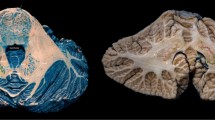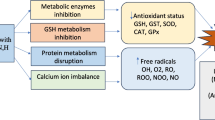Abstract
Fluoride is frequently added to drinking water supplies, various food products, toothpaste, and mouth rinses to prevent tooth damage. However, at high concentrations, fluoride can cause fluorosis and damage to the brain tissue due to its excitotoxicity and oxidative stress effects. The damage of the Purkinje cells of the cerebellum can lead to motor coordination disorders. The present study aimed at investigating the effects of sodium fluoride on the motor coordination and the number of Purkinje cells of the cerebellum of rats. Adult male Wistar rats were divided into four groups, namely a control group which received reverse osmosis distilled water and three treated groups which received sodium fluoride at doses of 5, 10, or 20 mg/kg bw. The treatment lasted for 30 days. The motor coordination of the rats was examined using a rotarod prior and subsequent to the treatments. The number of Purkinje cells was estimated using physical fractionator design. The numbers of Purkinje cells of the F10 and F20 groups were significantly lower than that of the control group. No significant differences in the results of the motor coordination test were found. The administration of sodium fluoride at doses of 10 and 20 mg/kg bw caused a decrease in the number of Purkinje cells of the cerebellum in rats.







Similar content being viewed by others
References
Chouhan S, Flora SJ (2010) Arsenic and fluoride: two major ground water pollutants. Indian J Exp Biol 48(7):666–678
Jha SK, Singh RK, Damodaran T, Mishra VK, Sharma DK (2013) Fluoride in groundwater: toxicological exposure and remedies. J Toxicol Environ Health B Crit Rev 16:52–66
Ricomini FAP, Tenuta LM, Fernandes FS, Calvo AF, Kusano SC, CJ A (2012) Fluoride concentration in the top-selling Brazilian toothpastes purchased at different regions. Braz Dent J 23:45–48
Mullenix PJ, Denbesten PK, Schunior A, Kernam WJ (1995) Neurotoxicity of sodium fluoride in rats. Neurotoxicol Teratol 17(2):169–177
Vani ML, Reddy KP (2000) Effects of fluoride accumulation on some enzymes of the brain and on the gastrocnemius muscle of mice. Fluoride 33:17–26
Dhar V, Bhatnagar M (2009) Physiology and toxicity of fluoride. Indian J Dent Res 20:350–355
Bhatnagar M, Rao P, Saxena A, Bhatnagar R, Meena P, Barbar S, Chouhan A, Vimal S (2006) Biochemical changes in brain and other tissues of young adult female mice from fluoride in their drinking water. Fluoride 39(4):280–284
Atmaca N, Atmaca HT, Kanici A, Anteplioglu T (2014) Protective effect of resveratrol on sodium fluoride-induced oxidative stress, hepatotoxicity and neurotoxicity in rats. Food Chem Toxicol 70:191–197
Pereira M, Dombrowski PA, Losso EM, Chioca LR, Cunha CD, Andreatini R (2011) Memory impairment induced by sodium fluoride is associated with changes in brain monoamine levels. Neurotox Res 19:55–62
Akinrinade ID, Ogundele OM, Memudu AE, Adefule AK, Kalejaiye ED (2013) Degeneration of neuronal cells: a product of fluoride and aluminium assault to the prefrontal cortex. J Cell Anim Biol 7(6):63–66
Chirumari K, Reddy PK (2007) Dose-dependent effects of fluoride on neurochemical milieu in the hippocampus and neocortex of rat brain. Fluoride 40(2):101–110
Al-Hayani A, Elshal EB, Aal IHA, Al-Shammeri E (2013) Does vitamin E protect against sodium fluoride toxicity on the cerebellar cortex of albino rats? Middle-East J Sci Res 16(7):1019–1026
Afifi OK (2009) Effect of sodium fluoride on the cerebellar cortex of adult albino rats and the possible protective role of vitamin B6: a light and electron microscopic study. Egypt J Histol 32(2):358–367
El-Dien SHM, El-Gamal DA, Mubarak HA, Saleh SM (2010) Effect of fluoride on rat cerebellar cortex: light and electron microscopic studies. Egypt J Histol 33:245–246
Mauk MD, Thach WT (2008) Cerebellum. In: Squire L, Berg D, Bloom F, du Lac S, Ghosh A, Spitzer N (eds) Fundamental Neuroscience. Academic Press, San Diego, pp 751–774
Hall JE (2016) Guyton and Hall’s textbook of medical physiology. Elsevier, Philadelphia
Hendelman WJ (2006) Atlas of functional neuroanatomy. CRC Press, Boca Raton
Bhatnagar M, Rao P, Sushma J, Bhatnagar R (2002) Neurotoxicity of fluoride neurodegeneration in hippocampus of female mice. Indian J Exp Biol 40:546–554
Ekambaram P, Paul V (2001) Calcium preventing locomotor behavioral and dental toxicities of fluoride by decreasing serum fluoride level in rats. Environ Toxicol Pharmacol 9:141–146
Pulungan ZSA, Sofro ZM, Partadiredja G (2016) Sodium fluoride does not affect the working memory and number of pyramidal cells in rat medial prefrontal cortex. Anat Sci Int 93:128–138. https://doi.org/10.1007/s12565-016-0384-4
Ekambaram P, Paul V (2002) Modulation of fluoride toxicity in rats by calcium carbonate and by withdrawal of fluoride exposure. Pharmacol Toxicol 90:53–58
Boulton IC, Cooke JA, Johnson MS (1995) Fluoride accumulation and toxicity in laboratory populations of wild small mammals and white mice. J Appl Toxicol 15:423–431
Candelario-Jalil E, Gonzales-Falcon A, Garcia-Cabrera M, Leon OS, Fiebich BL (2004) Wide therapeutic time window for nimesulide neuroprotection in a model of transient focal cerebral ischemia in the rat. Brain Res 1007:98–108
Aminuddin M, Partadiredja G, Sari DCR (2015) The effects of black garlic (Allium sativum L.) ethanol extract on the estimated total number of Purkinje cells and motor coordination of male adolescent Wistar rats treated with monosodium glutamate. Anat Sci Int 90:75–81
Partadiredja G, Bedi KS (2011) Mice undernourished before, but not after, weaning perform better in motor coordination and spatial learning tasks than well-fed controls. Nutr Neurosci 14(4):129–137
Partadiredja G, Sutarman YTN, Nuryana CT, Susilowati R (2013) Curcumin alters motor coordination but not total number of Purkinje cells in the cerebellum of adolescent male Wistar rats. J Integr Med 11(1):32–38
Shiotsuki H, Yoshimi K, Shimo Y, Funayama M, Takamatsu Y, Ikeda K, Takahashi R, Kitazawa S, Hattori N (2010) A rotarod test for evaluation of motor skill learning. J Neurosci Methods 189(2):180–185
Sterio DC (1984) The unbiased estimation of number and sizes of arbitrary particles using the disector. J Microsc 134:127–136
Nyengaard JR (1999) Stereologic methods and their application in kidney research. J Am Soc Nephrol 10:1100–1123
Prastiwi D, Djunaidi A, Partadiredja G (2015) High dosage of monosodium glutamate causes deficits of the motor coordination and the number of cerebellar Purkinje cells of rats. Hum Exp Toxicol 34(11):1171–1179
Sokal RR, Rohlf FJ (1995) Biometry. The principles and practice of statistics in biological research. W. H. Freeman & Co., New York
West MJ (2012) Basic stereology for biologists and neuroscientists. Cold Spring Harbor Laboratory Press, USA
Yuliani S, Mustofa, Partadiredja G (2017) Turmeric (Curcuma longa L.) extract may prevent the deterioration of spatial memory and the deficit of estimated total number of hippocampal pyramidal cells of trimethyltin-exposed rats. Drug Chem Toxicol. https://doi.org/10.1080/01480545.2017.1293087:1-10
Agustina F (2015) The effects of sodium fluoride administration on the number of cerebellar Purkinje cells and motor coordination of adult male Wistar rats (Rattus norvegicus) [Pengaruh pemberian natrium fluorida terhadap jumlah sel Purkinje cerebellum dan koordinasi motorik tikus Wistar (Rattus novergicus) jantan dewasa [Indonesian]). Department of Physiology, Faculty of Medicine, Universitas Gadjah Mada, Yogyakarta. Yogyakarta, Universitas Gadjah Mada
El-Sherif NM, El-Kholy WB (2015) The possible protective effect of nigella sativa oil on sodium fluoride neurotoxicity in adult male albino rat. Aust J Basic Appl Sci 9(2):346–361
Sárközi K, Máté Z, Vezér T (2012) General and behavioral toxicological effects of subchronic inorganic arsenic and fluoride treatment in adult Wistar rats. Eur Chem Bull 1(12):531–534
Ito M, Yamaguchi K, Nagao S, Yamazaki T (2014). Long-term depression as a model of cerebellar plasticity. In: Ramnani N (ed) Progress in brain research, 210. Elsevier BV, Amsterdam, pp 1–30
Freeman JH (2015) Cerebellar learning mechanisms. Brain Res 1621:260–269
Nishiyama H (2014) Learning-induced structural plasticity in the cerebellum. In: Mauk MD (ed) International review of neurobiology, 117. Burlington, Academic Press, pp 1–19
Mapelli L, Pagani M, Garrido JA, D’Angelo E (2015) Integrated plasticity at inhibitory and excitatory synapses in the cerebellar circuit. Front Cell Neurosci 9:1–17
Galliano E, De Zeeuw CI (2014). Questioning the cerebellar doctrine. In: Ramnani N (ed) Progress in brain research, 210. Elsevier BV, Amsterdam, pp 59–77
D’Angelo E (2014). The organization of plasticity in the cerebellar cortex: from synapses to control. In: Ramnani N (ed) Progress in brain research, 210. Elsevier BV, Amsterdam, pp 31–58
Suryanti S, Partadiredja G, Atthobari J (2015) Red sorrel (Hibiscus Sabdariffa) prevents the ethanol-induced deficits of Purkinje cells in the cerebellum. Bratisl Lek Listy 116(2):109–114
Barbier O, Arreola-Mendoza L, Del Razo LM (2010) Molecular mechanisms of fluoride toxicity. Chem Biol Interact 188:319–333
Zakhari S (2006) Overview: how is alcohol metabolized by the body? Alcohol Res Health 29(4):245–254
Wang Y, Qin Z (2010) Molecular and cellular mechanisms of excitotoxic neuronal death. Apoptosis 15:1382–1402
Nair AB, Jacob S (2016) A simple practice guide for dose conversion between animals and human. J Basic Clin Pharm 7:27–31
O’Mullane DM, Baez RJ, Jones S, Lennon MA, Petersen PE, Rugg-Gunn AJ, Whelton H, Whitford GM (2016) Fluoride and oral health. Community Dent Health 33:69–99
Acknowledgments
The present study was a part of Fitriani Agustina’s master thesis (Pengaruh pemberian natrium fluorida terhadap jumlah sel Purkinje cerebellum dan koordinasi motorik tikus Wistar (Rattus Novergicus) Jantan Dewasa [Indonesian]). The authors would like to thank Suparno, Wakidi (Department of Physiology, Faculty of Medicine, Public Health and Nursing, Universitas Gadjah Mada (UGM), Indonesia and Y. Suhardi (Department of Histology and Cell Biology, Faculty of Medicine, Public Health and Nursing, UGM, Indonesia) for their technical assistance, as well as Erik C. Hookom for language editing.
Funding
This study was partially funded by the Master in Biomedical Sciences Study Programme of the Faculty of Medicine, Public Health and Nursing, Universitas Gadjah Mada.
Author information
Authors and Affiliations
Corresponding author
Ethics declarations
The experimental procedure was approved by the Ethics Committee of the Faculty of Medicine, Public Health and Nursing, Universitas Gadjah Mada (approval number KE/FK/224/EC).
Conflict of Interest
The authors declare that they have no conflict of interest.
Ethical Approval
All applicable international, national, and/or institutional guidelines for the care and use of animals were followed. All procedures performed in studies involving animals were in accordance with the ethical standards of the institution or practice at which the studies were conducted.
Rights and permissions
About this article
Cite this article
Agustina, F., Sofro, Z.M. & Partadiredja, G. Subchronic Administration of High-Dose Sodium Fluoride Causes Deficits in Cerebellar Purkinje Cells But Not Motor Coordination of Rats. Biol Trace Elem Res 188, 424–433 (2019). https://doi.org/10.1007/s12011-018-1420-0
Received:
Accepted:
Published:
Issue Date:
DOI: https://doi.org/10.1007/s12011-018-1420-0




